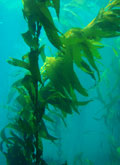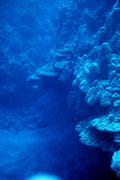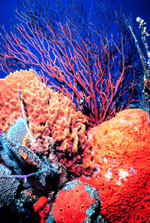|
Home > Ocean > Ocean Zones > Sunlight Zone
Understanding Ocean Zones: The Sunlight Zone
This ocean zone is from the surface of the sea down
to a depth of about 200 meters. As you begin your descent you see that
the ocean is absolutely teeming with life forms of every sort. From
the microscopic plankton and diatoms that give the ocean its murky
color and limits visibility, to bony fishes of every shape and size,
to starfishes, and warm-blooded, oxygen-breathing mammals. You can
see the most fantastic array of colors; reds, pinks, purples, bright
yellows, oranges, blues, greens. Everywhere you look the ocean is
brimming with brightly colored life forms, much more so than anything
on land. As you swim down deeper, it seems that the colors begin to
fade and the palette of life is becoming more monochromatic. In fact,
the colors are not disappearing, you simply are not able to see them.
Water, especially murky, turbid water, scatters and absorbs some of
the sun's light, filtering out colors below certain depths.
 The first colors to go are the reds, then oranges, yellows, greens,
and then finally blues. You may reach a certain depth, say about 60
feet, and it appears that everything around you is shades of brown,
black, gray and white. But lucky for you – you brought a bright
dive light. You turn on the light and once again marvel at the incredible
variety of colors, even at that depth. The sunlight zone of the The first colors to go are the reds, then oranges, yellows, greens,
and then finally blues. You may reach a certain depth, say about 60
feet, and it appears that everything around you is shades of brown,
black, gray and white. But lucky for you – you brought a bright
dive light. You turn on the light and once again marvel at the incredible
variety of colors, even at that depth. The sunlight zone of the  sea
contains some of the most plentiful, but tiny organisms in the ocean,
krill (a type of crustacean). Their existence is responsible for sustaining
the largest living creatures on earth – the Blue
Whales. sea
contains some of the most plentiful, but tiny organisms in the ocean,
krill (a type of crustacean). Their existence is responsible for sustaining
the largest living creatures on earth – the Blue
Whales.
 As you dive deeper in the sunlight life zone of
the sea, you will also quickly notice the effects of hydrostatic pressure on your body. The deeper you dive the more water is over the top of
you. The more gallons of water you put between you and the surface
of the ocean, the greater the pressure is on your body because of
the weight of the water over the top of you. You can really get a
sense of hydrostatic pressure as you dive deeper because you'll feel
the pressure against your ear drums, like they're being squeezed, or
pushed in. You'll need to equalize the pressure against your
eardrums to avoid rupturing them, so you descend slowly to prevent
them from being damaged. Once you get down to about a depth of 100
feet you will feel the pressure against every square inch of your
body. It really becomes noticeable as you breathe. At a depth of 100
feet, the size and volume of your lungs has been reduced to 1/3rd
their capacity at sea level. You will also notice that it is much
darker at 100 feet and COLD. The lack of sunlight at that depth also
means the ocean is not getting warmed by sunlight, either. At a depth
of about 180 feet you've pretty much reached the limit of safe
diving for a human breathing compressed air. Because of the possible
hazards of nitrogen narcosis, hypothermia, fatigue, and the need for
decompression after a deep dive, you'll need to return to the
surface and put on a special suit to dive deeper into the next zone...the twilight zone. As you dive deeper in the sunlight life zone of
the sea, you will also quickly notice the effects of hydrostatic pressure on your body. The deeper you dive the more water is over the top of
you. The more gallons of water you put between you and the surface
of the ocean, the greater the pressure is on your body because of
the weight of the water over the top of you. You can really get a
sense of hydrostatic pressure as you dive deeper because you'll feel
the pressure against your ear drums, like they're being squeezed, or
pushed in. You'll need to equalize the pressure against your
eardrums to avoid rupturing them, so you descend slowly to prevent
them from being damaged. Once you get down to about a depth of 100
feet you will feel the pressure against every square inch of your
body. It really becomes noticeable as you breathe. At a depth of 100
feet, the size and volume of your lungs has been reduced to 1/3rd
their capacity at sea level. You will also notice that it is much
darker at 100 feet and COLD. The lack of sunlight at that depth also
means the ocean is not getting warmed by sunlight, either. At a depth
of about 180 feet you've pretty much reached the limit of safe
diving for a human breathing compressed air. Because of the possible
hazards of nitrogen narcosis, hypothermia, fatigue, and the need for
decompression after a deep dive, you'll need to return to the
surface and put on a special suit to dive deeper into the next zone...the twilight zone.
|


 The first colors to go are the reds, then oranges, yellows, greens,
and then finally blues. You may reach a certain depth, say about 60
feet, and it appears that everything around you is shades of brown,
black, gray and white. But lucky for you – you brought a bright
dive light. You turn on the light and once again marvel at the incredible
variety of colors, even at that depth. The sunlight zone of the
The first colors to go are the reds, then oranges, yellows, greens,
and then finally blues. You may reach a certain depth, say about 60
feet, and it appears that everything around you is shades of brown,
black, gray and white. But lucky for you – you brought a bright
dive light. You turn on the light and once again marvel at the incredible
variety of colors, even at that depth. The sunlight zone of the  sea
contains some of the most plentiful, but tiny organisms in the ocean,
krill (a type of crustacean). Their existence is responsible for sustaining
the largest living creatures on earth – the Blue
Whales.
sea
contains some of the most plentiful, but tiny organisms in the ocean,
krill (a type of crustacean). Their existence is responsible for sustaining
the largest living creatures on earth – the Blue
Whales.